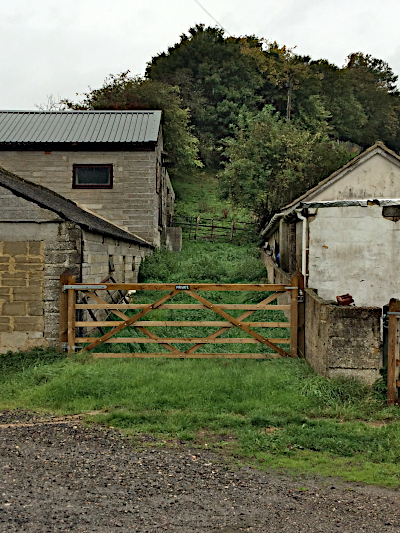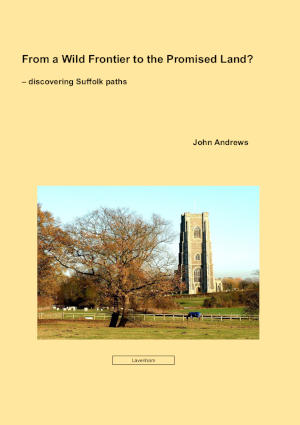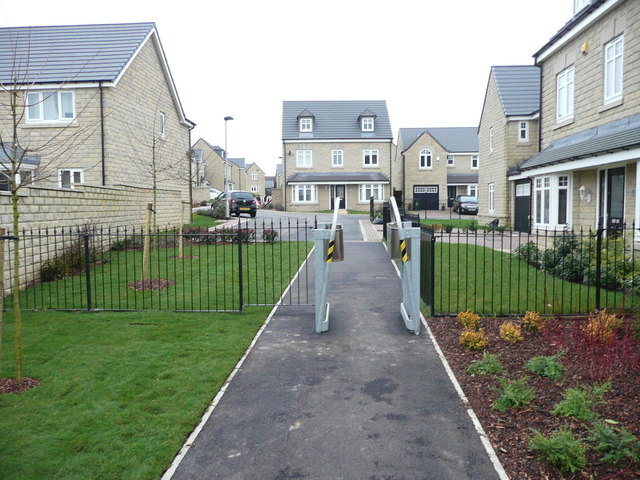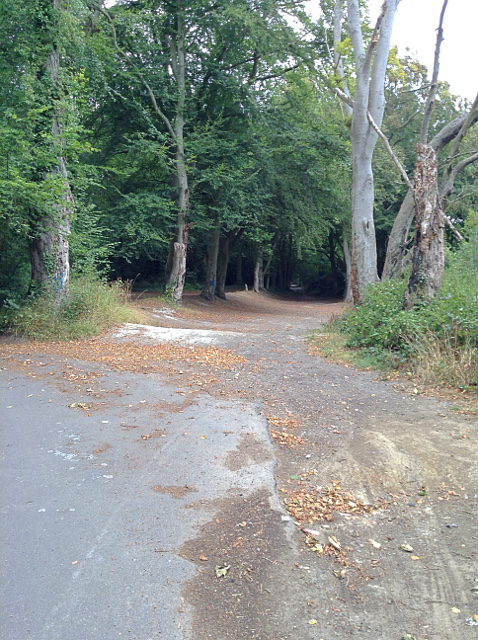This blog was edited on 15 May 2019 to include new text on the ‘presumption of regularity’ and the principle of res judicata.
The Planning Inspectorate does not like having rights of way inspectors. They are inflexible (because they are trained primarily to deal with rights of way and common land casework), and they cost too much (they are on a higher grade than the basic planning inspector intake grade). And besides, the Inspectorate is focused on delivering planning casework to fulfil the Government’s ambition to promote development: anything else is a distraction.
So increasingly the inspectorate assigns rights of way and commons casework to a wider cadre of inspectors, whose ‘day job’ is to deal with humdrum appeals against refusal of planning permission. In theory, these inspectors will be trained for the purpose — but just how effective is that training? And initially they will be supervised by more experienced inspectors — but how effective is that supervision?
A decision by one such inspector, in relation to two definitive map modification orders to add three footpaths to the definitive map for Devon, suggests that the answer to both questions is ‘minimally’.
The orders are the Devon County Council (Footpaths Nos. 60 and 61, Luppitt) Definitive Map Modification Order 2017 and the Devon County Council (Footpath No. 62, Luppitt) Definitive Map Modification Order 2017. The orders are available embedded with the start notice here (at the bottom of the Devon list). There are three claimed footpaths:
- Footpath 60 (referred to in the decision letter as part of order A), from just east of Wick Cross, southeast near the southern boundary of Dumpdon Hill, south (to the east of Crown All Wood), picking up the track to Woodhayes, then south to the road just short of the parish boundary.
- Footpath 61 (referred to in the decision letter also as part of order A), from Lower Wick Farm, southeast, through the southern end of Crown All Wood, then picking up the track to Woodhayes by joining footpath 60.
- Footpath 62 (order B) is further north, from Luppitt village, branching off footpath 1, generally a little south of southwest to join the road at the bend a little south of Greenland.
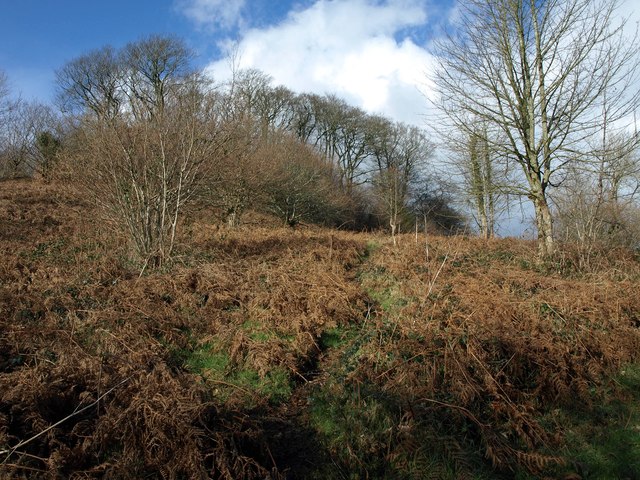 |
| Dumpdon Hill, Devon View of the hillfort from footpath 60 Photo © Derek Harper cc-by-sa |
The paths are all visible on old Ordnance Survey County Series mapping, at least up until the Second World War, and in the case of footpath 62, it was still being shown on the Ordnance Survey National Grid plan as late as the 1960s — see, for the County Series first edition, the links to 60, 61 and 62 (you may need to zoom in or out to view the relevant OS map, and can switch to later editions to compare).
The inspector’s decision letter is available here (scroll down to the relevant decision). The orders were sought on behalf of the Ramblers, and contested by some local landowners: the inspector does not bother to record who objected, only who represented the objectors.
There are a number of factual difficulties with the analysis. Let’s begin with these, first in relation to footpaths 60 and 61.
Paras.15–18, on historical mapping evidence, are not obviously reconcilable with the facts so far as they are disclosed in the decision letter. The inspector refers consistently to ‘one-inch’ maps, but appears to be confused, possibly meaning to refer in certain places to 1:2,500 (i.e., twenty-five inch) maps. For example, at para.15, he states that: ‘By 1889, the OS one-inch, first edition map shows the whole of the route along the line of FP60.’ But the first edition one-inch map (the Old Series) was published at the start of the nineteenth century, and doesn’t show the way — nor would one expect it to show a cross-field footpath. Nor does the Revised New Series one-inch map. Presumably, he means to refer to the Ordnance Survey County Series first edition 1:2,500 map published around 1889 — which does show the way. If a rights of way inspector cannot even get this right, what is he doing determining rights of way cases? (For that matter, this isn’t a very promising basis on which to approach planning casework.) In the next sentence, the inspector says that: ‘The route is again shown on the 1946 one-inch map…’: perhaps this is a reference to the New Popular edition, which certainly shows the route.
But if this was an isolated slip, it is hard to make sense of the first sentence of para.16: ‘FP61 does not appear on any map until the 1946 one-inch map.’ Well — yes it does, it too is shown on the Ordnance Survey County Series first edition 1:2,500 map published around 1889. Now, if the inspector was indeed referring only to the one-inch map, that appears to be correct — although it would be a very odd if the supporters of the order referred only to one-inch maps to document a footpath — few footpaths were shown on nineteenth century Ordnance Survey one-inch maps. But as the previous reference in para.15 to the ‘1889…OS one-inch, first edition map’ appears to be a reference to the 1:2,500 map, it is hard to see that the inspector has a proper grasp of the map scales.
The position in relation to footpath 62 is more straightforward. The inspector simply records, at para.29, ‘There appears to be no dispute between the parties that the claimed route appears on a variety of OS maps dating from 1809 to 1937.’ Well, leaving aside that footpath 62 continues to appear on maps after 1937 (see below), I can find no trace of the way on the Ordnance Survey one-inch Old Series map of 1809 — nor would I expect to (unless the way were in fact an old lane now being used as a footpath)
As it happens, the County Series 1:2,500 maps show all three routes consistently from the County Series first edition published around 1889, but footpaths 60 and 61 have disappeared from the 1964 National Grid plan — whereas footpath 62 remarkably is still shown, some years after the definitive map had been published without it. (As an aside, it is interesting how the publication of public paths on Ordnance Survey one-inch mapping from the 1960s onwards, and only on 1:25,000 maps from the 1970s and 1980s onwards, had a chilling effect on the use of non-definitive rights of way: up until then, many ways, still marked on maps as a physical feature, continued to be used on the assumption that they were rights of way, until the new Ordnance Survey mapping implied that they were not, because they were not shown on the definitive map.)
Accordingly, the inspector’s conclusion at para.18 in relation to footpath 60 and 61 that, ‘The case for the physical existence of the FP61 is at best highly questionable’ is plainly incorrect, particularly when read alongside his statement at para.16 that, ‘Both sections of the Order route [i.e. footpaths 60 and 61] are marked F.P. on the 1948 edition map.’ (The ‘1948 edition map’ appears to be the 1:25,000 map referred to in para.15.) How can the physical existence be in doubt if it is marked on the map as a footpath? One might also conclude that the evidence in relation to footpaths 60 and 61 is therefore not ‘patchy’ (para.18) — only that the evidence does not greatly help with public status, because Ordnance Survey maps purport not to distinguish private and public rights of way. Perhaps the inspector merely means that there is only post-war evidence of the existence of footpath 61 — but that is only if one looks at smaller scale maps
And the conclusion (para.40) that the ‘historical mapping evidence is ambiguous with regard to Order route A [i.e. footpaths 60 and 61] but supports the physical existence of a path along the line of Order route B [i.e. footpath 62] during the first half of the 20th century and possibly before’ must also be wrong. While ‘ambiguous’ might be a reference to public/private status, it is clear from the following words that this is not what the inspector has in mind. But the historical mapping is all one way: the paths are shown consistently over several editions of large scale mapping, being omitted only after (and in the case of footpath 62, long after) the definitive map implied that there was none. And indeed, the statement as regards footpath 62 (‘supports the physical existence of a path…during the first half of the 20th century and possibly before’) is a contradiction of what was said in para.29: ‘…the claimed route appears on a variety of OS maps dating from 1809 to 1937.’ Admittedly, the inspector’s conclusion in para.29 as regards the 1809 map is wrong — but the way was certainly shown on the County Series first edition 1:2,500 map in 1889.
To be fair, we cannot tell from the decision letter exactly what evidence was provided to the inspector by either party (the surveying authority took a neutral stance) — but we can be quite sure that nineteenth century one-inch maps had nothing to offer, because early one-inch maps seldom showed cross-field footpaths.
Moving on, at para.27, the inspector notes a tree in Crown All Wood (through the southern end of which passes footpath 61) which is said to have blocked footpath for 150 years — yet the inspector has observed (para.16) that the footpath is shown on the 1948 map (and as we have seen, it has been marked on maps since the late nineteenth century).
Only one of the ways, footpath 62, appeared on the tithe map (para.29). There is some further weighty evidence cited in relation to footpath 62: quoting the inspector (para.35): ‘The Parish Council minute books show a consistent record of public money being spent to repair/replace footbridges on the Order route up until prior to the preparation of the Definitive Map. As it is most unlikely that the Parish Council would have spent public money on a private route, I consider that during the early part of the twentieth century there was a widespread belief that the Order route was a public right of way.’
None of these ways was admitted to the definitive map and statement originally compiled under Part IV of the National Parks and Access to the Countryside Act 1949 — obviously, else the orders would not have been made. Why not? Well, this was not a case where the ways were simply ignored (for whatever reason). Footpaths 60 and 61 were shown on the Luppitt parish map (prepared by the parish council, as was required under s.28 of the 1949 Act). But they were not shown on the surveying authority’s draft map (save for a section of footpath at Woodhayes Farm). It was proposed to add footpath 60 north from Woodhayes Farm on a review in 1959, but objections meant that nothing came of it. As the inspector states (para.22), ‘the exact reasons why the routes were proposed and then omitted at the various stages is not fully known today.’
Footpath 62 was recorded in the parish survey, and it was noted that it was shown in the map prepared under the Rights of Way Act 1932. But the claim schedule was marked ‘omit’, and the way was not included in the draft map. Again, the inspector notes (para.33) that, ‘It is not known why or who added these comments’.
In relation to all of footpaths 60, 61 and 62, the Ramblers had adduced evidence prepared under the Finance (1909–1910) Act 1910. The 1910 Act caused every property in England and Wales to be identified on maps and to be valued. The primary purpose was to charge a tax (increment levy) on any increase in value when the property was later sold or inherited. Two aspects of the valuation process relate to highways. First, public vehicular roads were usually excluded from adjoining landholdings and shown as ‘white roads’ (i.e. uncoloured) on the maps. Secondly, discounts from the valuation could be requested for land crossed by footpaths or bridleways: whether such a discount was sought was up to the landowner (it didn’t always pay to reduce the valuation, and anyway, landowners then as now might not want to record the existence of rights of way on formal documents). However, none of the records of the 1910 Act survey was available to the public until the 1980s.
The Ramblers’ evidence showed that deductions had been allowed for paths passing through the specific parcels of land crossed by all three claimed footpaths: given that there was no evidence of any other paths across these fields, it strongly suggested that the landowner recognised the public status of the paths at the time of the valuation.
The landowners, as objectors, pointed out that the ways had seen no use in living memory. This was hardly surprising: the ways were cross-field paths, not shown on modern maps, and presumably impassable. It was also stated that the estate crossed by the ways had been in strict settlement between 1824 and 1920, so that there was no-one with capacity to dedicate. However, the inspector does not explore the question in any more detail, such as whether the ways might have been dedicated before 1824.
So much for the facts. What about the analysis? In seeking to modify the definitive map, one must show not only that the claimed rights of way exists, but also that there has been a discovery of evidence: that is, that there is new evidence which, if the claimed way was previously under review, was not considered at that time. Thus, one cannot simply reopen a claim which was considered at an earlier date, on the basis of a fresh look at the same facts previously available. Having satisfied the ‘discovery’ test, the decision maker is then required to review all the evidence, taken together, to decide whether the claimed right of way exists, on the balance of probability.
In this case, there is no doubt that there is new evidence — that from the 1910 Act survey. So the ‘discovery’ test is satisfied, and the inspector can move on. But he does not. At both paras.29 and 30, the inspector is focused on whether evidence (the Ordnance Survey maps and the tithe map) is new: but it should not matter. This is repeated at para.36 in relation to the parish council minutes of work done on the footbridges. The inspector has accepted the discovery of new evidence, and that should be the end of the matter. What is the relevance of whether the other evidence is new or not? It is quite clear that the inspector is discounting anything which was previously available to the 1949 Act process — regardless of whether it was taken into account, and regardless of whether the decision-making process was reliable.
Let’s have a look at the assessment of the tithe evidence. In relation to footpath 62, the inspector notes (para.32) the observations in the parish survey form that, ‘The reasons for its inclusion are given as: “mentioned in P.C. minutes”‘. The comments of the Rural District Council are recorded as: ‘This footpath is shown on the map prepared under the Rights of Way Act 1932 as a public right of way.’ But the inspector also finds the tithe map supportive (para.29). The survey form is evidence that the tithe map was not used in the parish survey, else it would have been recorded in the survey form. Yet the inspector concludes (para.30) that, ‘…this evidence [i.e. the tithe map, along with old Ordnance Survey maps] cannot be considered to be new, as it was likely that is was available at the time when the DMS was being produced.’
The same issue arises with the parish council minutes of work done to footbridges on footpath 62. The inspector states (para.36), that, ‘This inevitably leads me to the conclusion that the minutes are not new evidence and that that (sic) their contents were properly taken into account in reaching the decision to omit the path from the Definitive Map process.’
Yes, the evidence was certainly available, but that does not mean it was used, and there is evidence that some of it was not used. We know that many parish councils relied primarily on parish opinion and memory (‘the evidence of the oldest inhabitants then living’) — not on documentary evidence. Strictly speaking, it should not matter whether the tithe or parish council minutes evidence is new or not — it is sufficient that there is discovery of new evidence from the 1910 Act documentation. But, given the way the inspector approached the determination, it clearly mattered to the inspector.
At para.34, the inspector gives ‘consideration weighing squarely’ against confirming the order to the omission of footpath 62 from the draft map, and the absence of any objection to the omission. But if there had been an objection, and the way were included, then there would be no order. And if the way had been included and an objection to its inclusion had been maintained, there would have been some determination of the matter, perhaps in a hearing before the county council committee, or in due course at quarter sessions. If it is right to place weight on the exclusion, for unknown reasons, of a way from the draft map, then every attempt to add a way to the map now starts from a huge disability — it will be said it cannot be a right of way because the parish council did not volunteer it for the draft map: the parish council knew best.
But parish councils were not a fair and impartial tribunal to judge whether a way was a public way, and should be included on the draft map. For a start, parish councils generally did not have or seek access to the common historical sources available to researchers today. Most rights of way were recorded by parish councils because they were reputed to be public paths, and were believed to have been used by the public for many years — not because there was documentary evidence of their existence. Often acting on poor advice, a parish council may have omitted a way from the parish map where the way was eligible to be recorded on the map, because:
- The parish council may have overlooked the way (including where the way was mainly in a neighbouring parish).
- The parish council may have considered the way, but concluded it was not a public right of way on the information then available to it (which may not have included any documentary evidence at all.)
- The parish council may have concluded that the way was not a candidate to be recorded on the definitive map and statement, because it was a public road, lane or drove and perceived not appropriate to a record of ‘footpaths’.
- The parish council may have decided not to claim the way as it was little used, intrusive, burdensome to maintain, or otherwise undesirable from the councillors’ or other local perspective, or taking into account other improper considerations.
- Or the council may have recorded a road or bridleway as a footpath, because there was little awareness of, and little perceived need to protect, higher rights, and minimal recreational equestrian use of ways to remind people of their true status.
Frequently, no record survives of how decisions were made (in the case of footpath 62, only a terse note of a decision — by whom? — to omit the way). And, perhaps the most telling defect in giving weight to such decisions, invariably we know nothing of the balance of evidence for and against the inclusion of a particular way. It is all very well knowing that, somehow, the parish council arrived at a decision to exclude a particular way — but was that a tough call, in which the parish meeting tested the evidence of witnesses and landowners, scrutinised old parish records, heard the reports of those who had walked the way during the parish survey, was split down the middle and the chairman exercised a casting vote to exclude it? Or was there ample evidence that there was no public right of way (perhaps witness evidence no longer available) and the decision to exclude was overwhelming? Or for that matter, was the decision to ‘omit’ taken by the parish chairman in a telephone call with the County Surveyor, without ratification by anyone else? We do not know, and with the increasing elapse of time since the 1949 Act survey, we shall never know.
The inspector treated the original decisions to omit the paths as effectively res judicata — decisions which carry considerable weight, and should not be overturned lightly. In relation to all three ways, the appearance (paras.20 and 32) is that the decisions to exclude the ways was taken or assented to by the parish council (footpath 60 was also reconsidered on what appears to be a review in 1959). The inspector’s reliance on the strength of those decisions to exclude is wrong for three reasons:
- The parish council did not have all the evidence before it — the 1910 Act evidence was not available, and the implication is that it did not consider the tithe map evidence in respect of footpaths 61 and 62. And if it had had all the evidence before it, we cannot know what the outcome would have been.
- The parish council took into account irrelevant reasons in reaching a conclusion — this is not only a general observation (see above), but it is a matter of fact recorded in para.27 of another inspector’s decision letter of 14 December 2017 in relation to footpath 21, Combe Raleigh and 59, Luppitt, where the inspector notes that: ‘The minutes of Luppitt parish meeting of 27 March 1956 records…that “Many of the paths were considered to be now not used and were crossed off”. At a further meeting on 24 April 1956 it was recorded the “Further footpaths were discussed, many were found to be of no public use and omitted”.’ In the present case, the inspector records (para.5) that he ‘assessed these Orders on their individual merits, I recognise the importance of consistency in such matters. Accordingly, I have had regard to [the previous] decision insofar as it is relevant to my consideration of these Orders.’ So the inspector was aware of the weakness of the parish decision-making process.
- The parish council was not intended to be a fair and independent tribunal for the purposes of its functions under the 1949 Act. And it was not one. It was not normally legally advised, and it may have had very little understanding of the law. It did not have to offer anyone an opportunity to be heard (apart, perhaps, from at a parish meeting). It was heavily influenced by the weight of opinion voiced at parish meetings, from those who were prepared to speak up. Those in charge of the process (the chairman of the parish council) were frequently not disinterested, but local landowners.
Accordingly, the decisions of the parish council to exclude the paths should have been afforded little or no weight. They should not have been treated as res judicata, a convincing vindication that the way does not exist. Still less where, as here, there is convincing new evidence — the 1910 Act evidence — which could not have been taken into account at the time.
The inspector does not mention res judicata, although that principle seems to have been on his mind. Instead, constantly the inspector refers to the presumption of regularity. At para.38, the inspector states that he: ‘must assume the County Council carried out their duties with proper diligence and therefore the “presumption of regularity” applies.’ Is there any evidence that the county council took the decision, or was even involved in it, to omit the way from the draft map? Indeed, we do not even know why the parish council ignored footpaths 60 and 61, and decided to omit footpath 62. At para.40, the inspector says that, ‘the Parish Council minutes in respect of Order route B would have been before the County Council when it made its decision to omit the route from the definitive map in the early 1950s.’ How does he know the parish council minutes were before the county council? And is there evidence that it was the county council which took that decision? What is the relevance of the presumption of regularity? Even a kangaroo court might observe its own rules — but that does not mean its verdict ought be afforded any more respect. What is wrong with the inspectors’ decisions is that they afford a degree of respect to the very part of the 1949 Act process which was, and was intended to be, its least reliable and most pragmatic element: the parish survey and submission.
What the inspector has done, particularly in relation to path 62, is to discount any evidence which either was before the local councils in the 1949 Act process, or could have been; concluded that the decision to omit the paths was correctly arrived at (assuming that proper process was sufficient to synthesise a correct decision) and founded in relevant evidence (as opposed to irrelevant evidence, such as the lack of need for the path); and looked for new evidence to the contrary, of such cogency that it could outweigh the decision to omit. This he fails to find in the 1910 Act evidence — which is hardly surprising, because the weight of the evidence to omit is unknowable. It is as if the inspector fears that the parish council had possession of a stopping up order, now lost. But there is no evidence of that. The likelihood is that the parish council, influenced by landowner objections, decided that there was no need for the ways, notwithstanding evidence that they were public rights of way, and decided to omit them. That, no doubt, is why the decision to omit is documented only by the one word itself — ‘omit’ (para.32). That was an unsurprising flaw in the 1949 Act process. But it does not deserve to undermine applications to rectify those flaws today.
The inspector’s decision in this case is insupportable. It is not only muddled, but it espouses an entirely new principle: that the exclusion of a way from the 1949 Act map represents a glorious synthesis of the opinion of the key participants at the time — local people, landowners, farmers, the parish council, the district council and the county council. But in so many cases, it was no more than a matter of oversight, or a shabby transaction conducted without adequate scrutiny.
Worse, this is not the only decision to adopt this principle: look at the determinations for Devon in 2019, and the decisions in respect of (Bridleway No.15, Thelbridge and Bridleway No. 14, Washford Pyne) Definitive Map Modification Order 2012 and the (Footpaths No. 21, Combe Raleigh and No. 59, Luppitt) Definitive Map Modification Order 2016. Both adopt a similar approach. This is the evidence for the Devonian disease of the title to this blog — three decision letters, broadly contemporary in date, all in relation to Devon, all passing over good quality historical evidence in favour of the sanctity of the 1949 Act process. Two of those decisions were taken by an experienced rights of way inspector, and one — the present case — by a less familiar ‘planning’ inspector. Was this coincidence? Or was the planning inspector under the tutelage of the more experienced rights of way inspector, by which the Devonian disease was contracted? Quite why an experienced inspector has fallen victim to the disease in two successive inquiries in the same area, and passed it on to a colleague, is unclear.
The Open Spaces Society has provided assistance with reviewing all three cases. The other two decisions were both considered by user groups at the time — the British Horse Society (BHS) looked at the Thelbridge decision, and the Ramblers at the Combe Raleigh decision. The BHS sought counsel’s opinion, but the prospects for success were insufficiently certain. Happily, the Ramblers has responded by challenging the Secretary of State on the Luppitt decision. Although he initially defended the decision, a judge granted leave for the matter to go to trial, and the Secretary of State then agreed to quash the decision (not before time). The decision has now been quashed (as is recorded on the gov.uk website), and the order will have to be redetermined. The Ramblers will now be able to address the issues raised by the inspector’s quashed determination at a future public inquiry, and we must hope that the outcome makes more sense. And I have prepared a paper for the BHS on ‘the parish role in preparing the definitive map’, which will enable those in support of such orders to show the weaknesses in the 1949 Act process, and why a decision to exclude a way cannot be relied upon as probative. It is too late for the Thelbridge and Combe Raleigh orders (though if further new evidence can be found, new applications can be made for definitive map modification orders), but the orders for the Luppitt ways will be redetermined, one hopes with the Devonian disease banished.
Postscript: see the subsequent blog, Luppitt 2: the Devonian disease — contagion for the next stage in this saga.

